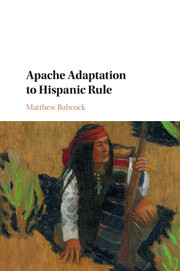Introduction
Published online by Cambridge University Press: 05 September 2016
Summary
In the spring of 1794 five hundred Apaches lived peacefully on a Spanish-run reservation surrounding Janos presidio in northwestern Nueva Vizcaya. Led by fifty-two-year-old nantan (leader) El Compá, these Indians called themselves Ndé (“The People”) and consisted of nine Chihene (“Red Paint People”) and two Chokonen (“Juniper People”) bands. Spaniards named them Mimbreños (“people of the willows”) and Chiricaguis (Ópata for “mountains of the wild turkey”) after the principal mountain ranges that they inhabited, the Sierras de las Mimbres and Chiricagui. Today they are better known as the Black Range of southwestern New Mexico and the Chiricahua Mountains of southeastern Arizona.
After initially making peace at Janos in late 1789, Ndé numbers rose steadily, reportedly reaching 312 in March of 1792 and 406 a year later. Rather than risk being killed, captured, imprisoned, or enslaved by Spanish troops and their Indian allies, these Apaches opted to receive rations and gifts in exchange for their men serving as scouts and auxiliary troops with Spanish soldiers. Apache families received weekly rations of beef, pinole (meal made of ground corn and mesquite beans), salt, maize, and cigars and periodic gifts of horses and sheep. Ten of the eleven Ndé bands lived close to the presidio and included such well-known leaders as Vívora, Tetsegoslán, and Nac-cogé (El Güero or “the light-haired one”). Most prominent of all was the Chokonen El Compá, whom Spaniards had named “principal chief of the peaceful Apaches” three years earlier. Favored over the other headmen, El Compá resided inside the walls of Janos presidio with more than fifty of his people, including his two well-known sons, the future Chihene leaders Juan José and Juan Diego Compá (Nayulchi).
The Ndé at Janos were not alone. A prolonged regional drought and coordinated attacks from Spanish troops and their Indian allies influenced thousands of Apaches to relocate and resettle in a group of reservation-like establecimientos (establishments or settlements) near Spanish presidios beginning in 1786. Stretching across more than nine hundred miles of arid desert and temperate mountains at its height in the late 1790s – from Laredo, in the east, to Tucson, in the west – this little-known Spanish experiment constituted the earliest and most extensive system of military-run reservations in the Americas.
- Type
- Chapter
- Information
- Apache Adaptation to Hispanic Rule , pp. 1 - 18Publisher: Cambridge University PressPrint publication year: 2016



